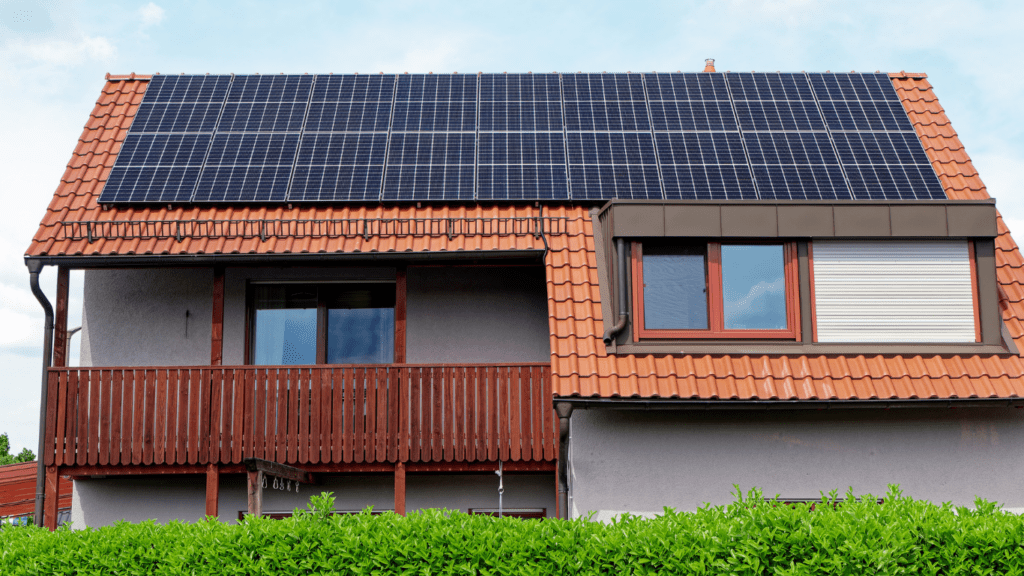Importance of Sustainable Home Building
Sustainable home building aims to minimize environmental impact by using eco-friendly materials and technologies. This effort combats climate change by reducing carbon footprints and conserving natural resources. According to the U.S. Green Building Council, buildings account for 39% of CO2 emissions in the United States, making it crucial to build sustainably.
Eco-friendly homes often use renewable energy sources, like solar panels and wind turbines. These technologies enhance energy efficiency and reduce dependence on fossil fuels. For instance, solar panels can cut household electricity bills by up to 70%.
Recycled materials in construction, such as reclaimed wood or recycled metal, reduce waste and lower the need for new raw materials. The use of recycled materials ensures a smaller ecological footprint during the building process. Additionally, sustainable homes improve indoor air quality by eliminating toxic chemicals found in traditional building materials.
Sustainable home building also supports local economies. Many eco-friendly materials are locally sourced, reducing transportation emissions and supporting community businesses. Moreover, energy-efficient homes reduce utility bills, resulting in long-term financial savings for homeowners.
Sustainable home building is essential for environmental preservation, resource conservation, and economic benefits. By incorporating renewable energy sources and recycled materials, we can build homes that are not only eco-friendly but also cost-effective and healthy to live in.
Key Eco-Friendly Building Materials
Using eco-friendly materials is essential for sustainable home building. These materials reduce environmental impact and enhance resource efficiency.
Recycled Steel
Recycled steel is one of the top materials for sustainable construction. It’s strong, durable, and 100% recyclable. By using recycled steel, we lower the demand for new steel, reducing CO2 emissions and conserving natural resources. For instance, producing steel from recycled materials uses 75% less energy than producing steel from raw materials.
Bamboo
Bamboo is a fast-growing renewable resource. It’s sustainable because it regrows quickly, often within five years, unlike hardwood which can take decades. Bamboo’s strength and flexibility make it ideal for various construction applications. Additionally, bamboo cultivation helps sequester carbon, contributing to a reduction in greenhouse gases.
Insulated Concrete Forms (ICFs)
ICFs are made of rigid thermal insulation that serves as a permanent interior and exterior substrate for walls, floors, and roofs. ICFs significantly enhance a building’s energy efficiency by providing superior insulation. They also add structural strength, reducing the amount of other materials needed. This dual benefit positions ICFs as a key element in sustainable home building.
Reclaimed Wood
Reclaimed wood is sourced from:
- old buildings
- barns
- factories
It’s a sustainable choice since it reduces the need for new timber, thereby conserving forests. Reclaimed wood also adds unique character and history to homes. It often has a look that new wood can’t replicate, bringing both aesthetic and environmental benefits.
Innovative Green Technologies

Innovation in green technologies drives the sustainable home-building movement. These technologies aim to enhance energy efficiency, reduce waste, and minimize environmental impact.
Solar Panels
- Solar panels harness the sun’s energy, converting it into electricity.
- Modern photovoltaic cells achieve up to 22% efficiency in energy conversion, making them a reliable renewable energy source.
- Installing solar panels can lower electricity bills by up to 50%, depending on sunlight exposure and local rates.
- These panels also reduce dependence on fossil fuels, cutting greenhouse gas emissions significantly.
- Flexible solar panels offer more installation options, accommodating various roof types and designs.
Green Roofs
Green roofs consist of a vegetative layer grown on a rooftop, providing insulation and reducing urban heat islands. They absorb rainwater, lowering runoff and relieving stormwater system pressure. Extensive green roofs support lightweight vegetation, while intensive green roofs can host a variety of plants, including small trees. In addition to enhancing biodiverse habitats in urban areas, green roofs improve air quality by filtering pollutants and carbon dioxide.
Energy-Efficient Windows
Energy-efficient windows minimize heat loss in winter and keep homes cooler in summer. Low-emissivity (Low-E) coatings on glass reflect heat into the room, improving insulation. Double or triple glazing windows feature gas-filled spaces between panes, enhancing thermal performance. These windows also reduce energy costs, with potential savings of 15% annually compared to traditional windows. Frames made from sustainable materials like recycled aluminum or uPVC further reduce environmental impact.
Benefits of Sustainable Home Building
Sustainable home building offers numerous advantages that extend beyond environmental preservation. By integrating eco-friendly practices, homeowners achieve financial, health, and ecological benefits.
Environmental Impact
Sustainable homes significantly reduce environmental impact by lowering CO2 emissions. Buildings account for 39% of CO2 emissions in the U.S., so eco-friendly materials like recycled steel and bamboo help conserve resources. Innovative technologies, such as green roofs and energy-efficient windows, further decrease carbon footprints. Reduced demand for new raw materials and recycling efforts minimize waste, while local sourcing cuts transportation emissions.
Cost Savings
Eco-friendly homes offer substantial cost savings in the long term. Energy-efficient technologies, such as solar panels and insulated concrete forms (ICFs), lower energy consumption. Solar panels can reduce electricity bills by up to 50%, and energy-efficient windows can save up to 15% on energy costs yearly. Additionally, using durable materials like recycled steel reduces maintenance costs over time.
Health and Well-Being
Sustainable building practices improve indoor air quality by eliminating toxic chemicals found in traditional materials. For instance, low-VOC paints and finishes minimize exposure to harmful substances. Enhanced insulation and ventilation systems ensure a healthier living environment. Green roofs and indoor plants also contribute to better air quality and overall mental well-being.
Challenges and Solutions
Building sustainable homes presents challenges that can hinder progress. However, practical solutions exist to address these obstacles.
Initial Costs
Sustainable materials often cost more upfront due to their innovative nature and limited market. For instance, solar panels and energy-efficient windows have higher initial prices compared to traditional options. Addressing this, tax credits and rebates can offset costs, making these investments more feasible. Energy savings over time also compensate for the higher upfront investment.
Availability of Materials
Eco-friendly materials can be scarce or hard to source, particularly in remote regions. For example, recycled steel or bamboo might not be readily available everywhere. To overcome this, sourcing locally available sustainable options, like reclaimed wood, can reduce costs and emissions associated with transportation. Collaborating with suppliers who focus on sustainable products can also ensure a steady material supply.
Skilled Labor
Skilled labor proficient in sustainable construction techniques may be limited. Traditional construction workers may lack expertise in handling materials like ICFs or installing green technologies. Training and certification programs can bridge this knowledge gap. Partnering with educational institutions or organizations that focus on green building can create a skilled workforce, ensuring high-quality sustainable construction.
Future Trends in Sustainable Home Building
Technological advancements and innovative materials are setting the stage for the future of sustainable home building. I explore three key trends in this section.
Smart Home Integrations
Smart home integrations enhance energy efficiency and sustainability, creating eco-friendly living spaces. Smart thermostats, for example, optimize energy usage by learning homeowners’ habits and automatically adjusting temperatures. Smart lighting systems use motion sensors to minimize energy waste, while smart water heaters reduce water usage through precise temperature control. These technologies contribute to reduced energy consumption and enhance the overall sustainability of homes.
Advanced Insulation Techniques
Advanced insulation techniques are crucial for achieving energy efficiency in sustainable homes. Aerogel insulation, known for its minimal thermal conductivity, significantly reduces heat loss. Structural Insulated Panels (SIPs) improve thermal performance and reduce construction waste. Another innovative technique, vacuum insulation panels (VIPs), deliver high thermal resistance in thin panels. By incorporating these advanced insulation solutions, homes maintain comfortable temperatures with lower energy consumption.
Water Conservation Systems
Water conservation systems play a vital role in sustainable home building. Rainwater harvesting systems collect and store rainwater for irrigation, flushing toilets, and other non-potable uses. Greywater recycling systems treat and reuse wastewater from sinks, showers, and washing machines. Low-flow fixtures, like faucets and showerheads, reduce water usage without compromising performance. Implementing these systems helps conserve water resources and supports sustainable living.



 Harry Marriott – Lead Interior Stylist
Harry Marriott is Castle Shelf House’s Lead Interior Stylist, known for his keen eye for detail and expertise in modern and classic home designs. With a background in interior architecture, Harry brings innovative styling solutions to the forefront, ensuring that each home reflects a unique personality. His approach to furniture placement and design trends helps clients create harmonious living spaces that combine aesthetics with functionality.
Harry Marriott – Lead Interior Stylist
Harry Marriott is Castle Shelf House’s Lead Interior Stylist, known for his keen eye for detail and expertise in modern and classic home designs. With a background in interior architecture, Harry brings innovative styling solutions to the forefront, ensuring that each home reflects a unique personality. His approach to furniture placement and design trends helps clients create harmonious living spaces that combine aesthetics with functionality.
